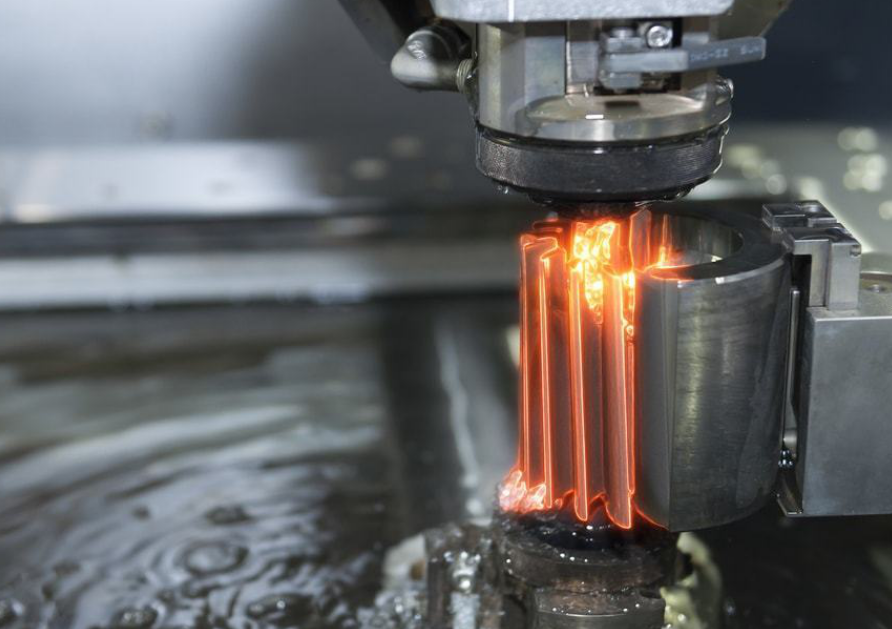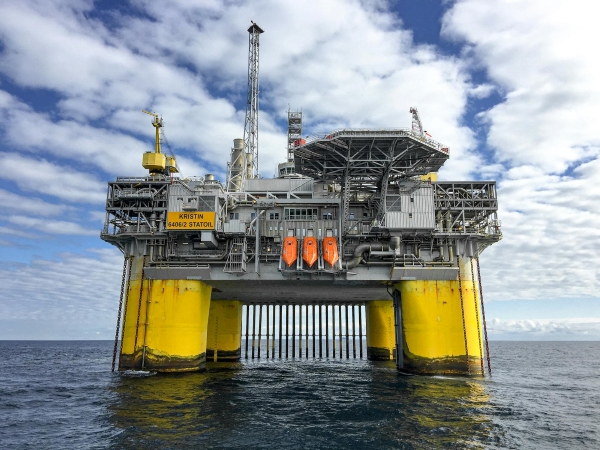A Closer Look at Piezoelectric Crystal
Introduction
Piezoelectric crystals are a class of crystalline materials capable of inducing changes in charge distribution and generating electric field responses through mechanical stress. The unique properties of this material make it useful in many fields, especially in sensor technology and energy conversion. The core feature is that piezoelectric crystals deform or redistribute charge when mechanical stress or an electric field is applied, enabling efficient conversion between electrical and mechanical energy. With the advancement of technology, the application fields of piezoelectric crystals are expanding. From smart materials to energy recovery technologies, their innovative potential leads to new opportunities and solutions for industry. An in-depth understanding of the properties and applications of piezoelectric crystals is therefore essential for understanding the direction of modern technology.
What Is a Piezoelectric Crystal?
A piezoelectric crystal is a non-centrosymmetric crystal. When subjected to mechanical force, it deforms, causing the relative displacement of charged plasma points. This results in positive and negative bound charges appearing on the crystal surface. When the external force is removed, the crystal returns to its uncharged state. This phenomenon is known as the piezoelectric effect.
The piezoelectric crystal has a polar axis with a potential difference at both ends, known as piezoelectricity. The amount of charge produced by a force applied to a crystal is directly proportional to the magnitude of the external force. Conversely, if an electric field is applied to the crystal, the crystal will be mechanically deformed in a certain direction; when the applied electric field is withdrawn, the deformation disappears. This phenomenon is called the inverse piezoelectric effect, also known as the electrostriction effect.
Crystal (α-quartz) is a well-known piezoelectric crystal. Common piezoelectric crystals include sphalerite, calcite, tourmaline, red zincite, GaAs, barium titanate and its derived structural crystals, KH2PO4, NaKC4H4O6-4H2O (rosette salt), and table sugar.

Fig. 1 Natural Quartz Crystals
Crystal Structure Characteristics of Piezoelectric Crystals
Piezoelectric crystals usually have a non-centrosymmetric crystal structure. Common piezoelectric materials such as quartz (SiO₂), barium titanate (BaTiO₃), and PZT ceramics (lead zirconium titanate) fall into this category.
In a non-centrosymmetric crystal structure, the electric dipoles (i.e., the centers of charge) do not cancel each other out so that the entire crystal exhibits a net electric dipole moment. The electric dipoles (consisting of positive and negative charge centers) inside a piezoelectric crystal are usually randomly distributed in the natural state and do not exhibit macroscopic polarization. Through a polarization treatment (heating above the Curie temperature, applying a strong electric field, and then cooling), the electric dipoles can be rearranged in the presence of an applied electric field to align them in the direction of the electric field, thus giving the material a permanently polarized state.

Fig. 2 Crystal Structure of Quartz (SiO2)
Principles of Piezoelectric Phenomena
When mechanical stress is applied to a piezoelectric crystal (e.g., compression or stretching), small displacements of the electric dipoles inside the crystal result in a redistribution of the charge centers, generating a charge on the surface of the crystal. This charge distribution produces a potential difference that can be measured and expressed as a piezoelectric voltage. This process of charge generation by pressure is the positive piezoelectric effect.
Accordingly, when an electric field is applied to a piezoelectric crystal, the electric dipoles inside the crystal rearrange or rotate in response to the electric field, resulting in mechanical deformation of the crystal. This deformation can drive mechanical motion, such as in a piezoelectric actuator. This phenomenon is called the inverse piezoelectric effect.
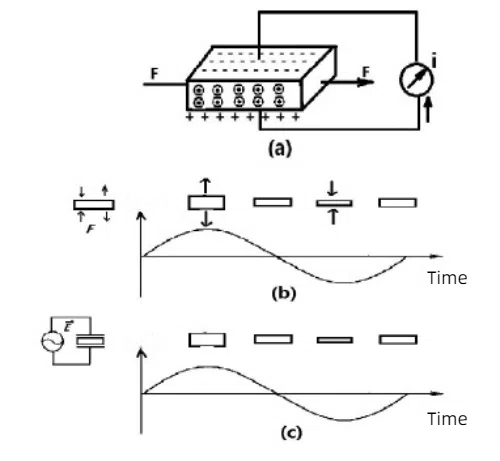
Fig. 3 Piezoelectric Effect
It is mainly caused by the rearrangement of electric dipoles and the coupling of stress and electric field. The rearrangement of the electric dipoles occurs mainly above the Curie temperature when the crystal structure of the piezoelectric material allows the electric dipoles to rotate freely. When an electric field is applied, the electric dipoles are aligned along the direction of the electric field. Upon cooling, the alignment direction of the electric dipoles is fixed, causing the material to exhibit macroscopic polarization. The coupling effect of stress and the electric field is manifested in that when mechanical stress is applied, the crystal structure undergoes minor changes, and the relative positions of the electric dipoles are altered, leading to the redistribution of the charge centers and the generation of electric charges; when an electric field is applied, the rearrangement of the electric dipoles leads to the deformation of the crystal structure and the generation of mechanical strains.
Polarization of Piezoelectric Crystals
What is Polarization?
The polarization of piezoelectric crystals is aligning the electric dipoles in a piezoelectric material in a specific direction by applying a strong electric field. This process gives the material the ability to acquire the piezoelectric effect and maximize its piezoelectric properties.
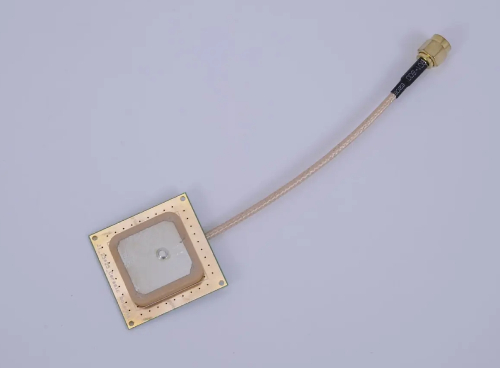
Fig. 4 Ceramic Polarization
Steps of Polarization Treatment
1. Preparation of materials: Piezoelectric materials (e.g. barium titanate, PZT ceramics, etc.) are prepared to the desired shape and size.
2. Heating: Heat the material above its Curie temperature. Curie temperature is the temperature at which the material changes from a ferroelectric phase to a cis-electric phase. At this temperature, the electric dipoles within the material are in a randomly oriented state.
3. Applied electric field: A strong electric field (usually a few thousand volts per millimeter) is applied to the material at a high temperature. This electric field causes the electric dipoles inside the material to rearrange and align themselves in the direction of the electric field.
4. Cooling: The material is cooled below the Curie temperature while maintaining the electric field. During the cooling process, the electric dipoles remain aligned along the direction of the electric field, resulting in a permanently polarized state of the material.
5. Removal of the electric field: After the material is cooled to room temperature, the external electric field can be removed, at which point the material has acquired permanent piezoelectric properties.
Principle of Polarization Processing
When the material is above the Curie temperature, the piezoelectric material is in the cis-phase, and the electric dipoles are free to rotate and rearrange. At this time to strengthen the electric field so that the electric dipole along the direction of the electric field alignment, the formation of a unified polarization direction. After the desired polarization direction is reached, the temperature is lowered to allow cooling. The cooling process fixes the alignment of the dipoles so that they remain polarized in the absence of an external electric field.
Importance of Polarization Treatment
Polarization treatment is critical to the performance of piezoelectric materials. Unpolarized materials do not exhibit significant piezoelectric effects, and the piezoelectric properties (e.g., piezoelectric coefficient) of polarized materials are greatly improved, enabling them to efficiently convert mechanical and electrical energy. It is through polarization that piezoelectric materials can achieve their superior performance in applications such as sensors, actuators, and electronic components.
Common Piezoelectric Materials and Their Applications
1. Quartz
Quartz is a widely used natural piezoelectric crystal, because of its stability and high performance in many fields. Its chemical composition for the hexagonal crystal system of silicon dioxide (SiO2), the appearance of the general colorless transparent crystal. The low coefficient of thermal expansion (ordinary quartz has a coefficient of thermal expansion of about 0.5*10^-6/°C) and high-quality factor (quartz has a quality factor of about 115*1000) allow quartz to excel in high-frequency oscillators and filters even with relatively low piezoelectric coefficients. Quartz has excellent chemical and mechanical stability and maintains its piezoelectric properties over a wide temperature range.
Quartz crystals are usually prepared both naturally mined and synthetically synthesized. As a natural mineral, quartz crystals are relatively easy and inexpensive to obtain. Synthetic quartz can often be used to meet high purity and specific size requirements. The cutting and processing of quartz crystals can be precisely controlled to ensure optimum performance in the application. Different cutting directions affect the piezoelectric properties of quartz, such as AT cut and BT cut.
Quartz crystal oscillators are used in electronic devices such as quartz watches, computers, and cellular phones to provide accurate time references. Filters made of quartz crystals can be used in wireless communication devices to ensure the quality and stability of signal transmission. Quartz crystals are also used in pressure sensors, accelerometers, and microphones to convert mechanical vibrations into electrical signals in a wide range of industrial automation, aerospace, and audio equipment.
Applications for quartz in surface acoustic wave (SAW) devices include SAW filters and SAW sensors for signal processing and environmental monitoring. In optical equipment, quartz crystals are used to make optical modulators, prisms, and lenses. In ultrasound equipment, quartz crystal ultrasonic transducers are used for medical diagnostics and industrial testing. In the field of metrology and test equipment, quartz crystals are used as standard frequency sources in frequency meters and signal generators. Quartz has an indispensable position in modern technology and industry due to its high stability, high precision, and low cost.
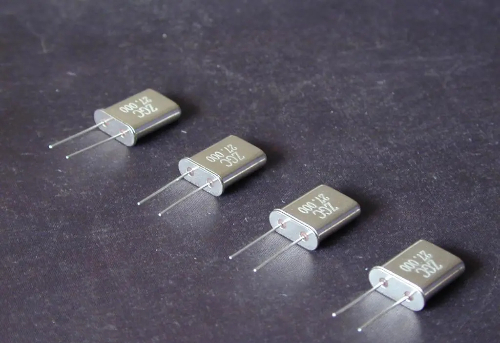
Fig. 5 Quartz Crystal Filters
2 Barium Titanate
Barium titanate (BaTiO3), normally colorless or white crystals, has a chalcogenide structure (with different crystalline phases at different temperatures, such as tetragonal, cubic, and hexagonal). The piezoelectric properties of barium titanate originate from the crystalline phase transition and symmetry breaking in its chalcogenide structure due to temperature changes. Barium titanate maintains its piezoelectric properties over a wide range of temperatures, making it suitable for use in a variety of environmental conditions.
The high piezoelectric constants of barium titanate (d31 is about -80 x 10^-12 C/N, while d33 is about 190 x 10^-12 C/N) give it excellent performance in many applications. The high dielectric constant of barium titanate gives it a high capacitance in capacitor applications. At room temperature, its natural dielectric constant is about 1200.
In electronic devices, barium titanate is used in the manufacture of multilayer ceramic capacitors (MLCCs), which have high capacitance and small size and are widely used in smartphones, computers, and household appliances. In the field of sensors, barium titanate is used in the manufacture of pressure sensors and acceleration sensors, which are used in industrial automation, medical equipment, and automotive electronics.
Barium titanate is also used in the manufacture of piezoelectric actuators, which produce mechanical deformation under voltage and are used in precision positioning systems, microelectromechanical systems (MEMS), and optical alignment. Ultrasonic transducers are another important application for barium titanate, which is widely used in medical ultrasonic diagnostics, industrial non-destructive testing, and ultrasonic cleaning equipment.
Barium titanate is also used in piezoelectric filters and resonators in wireless communication systems to ensure signal clarity and transmission quality. In addition, the piezoelectric properties of barium titanate are used to develop piezoelectric energy harvesting devices that convert mechanical vibration or kinetic energy from the environment into electrical energy to power low-power devices.
Barium titanate also has applications in electroacoustic converters such as speakers and microphones, converting electrical signals into sound waves or vice versa. Its applications in medical devices include piezoelectric-driven medical instruments such as micropumps and precision drug delivery systems. Because of its high piezoelectric constant and good stability, barium titanate plays an important role in modern electronics, communications, medical, and industrial automation.
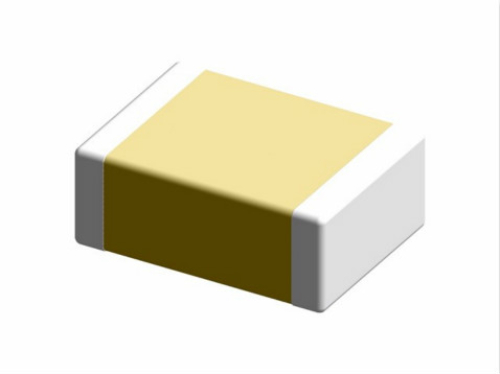
Fig. 6 Multilayer Ceramic Capacitors
3 Lead Zirconate Titanate (PZT)
Lead Zirconate Titanate (PZT) is a very important and widely used piezoelectric ceramic material. The chemical formula is Pb(ZrₓTi₁₋ₓ)O₃, and the structure of PZT can be varied at different Zr/Ti ratios, including the chalcocite-type structure. PZT undergoes phase transitions (e.g., from tetragonal to cubic phases) at different temperatures, and these transitions affect its piezoelectric properties.
In ultrasonic devices, PZT is used to make transducers for medical ultrasound diagnostics, industrial non-destructive testing, and underwater sonar systems. The sensor field utilizes the piezoelectric effect of PZT to make pressure sensors and acceleration sensors for applications in industrial automation, medical devices, automotive safety systems, and seismic monitoring.
PZT piezoelectric actuators produce mechanical deformations under the action of an electric field and are used for precision positioning, optical adjustments, and fine-motion control in printing devices and microscopes. In addition, PZT materials are used as piezoelectric filters and resonators in wireless communication systems to ensure signal clarity and transmission quality.
In energy harvesting, PZT converts mechanical energy or vibrational energy in the environment into electrical energy to feed wireless sensor networks and wearable devices. PZT is also used to make speakers and microphones that convert electrical signals into sound waves or vice versa. Its high piezoelectric constant and high electromechanical coupling coefficient make it play an important role in the fields of modern electronics, communications, medicine, and industrial automation.
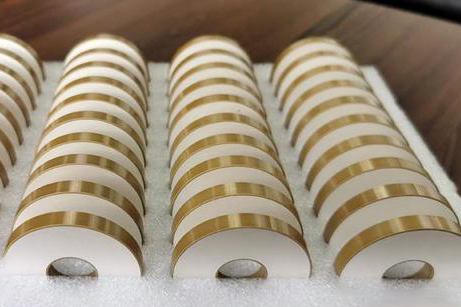
Fig. 7 Lead Zirconate Titanate Piezoelectric Ceramic Sheet
4 Zinc Oxide (ZnO)
Zinc oxide has a hexagonal wurtzite structure, which is a non-centrosymmetric structure that gives it piezoelectric properties. The Zn²⁺ and O²- ions in the hexagonal wurtzite structure generate an electric dipole moment under stress, resulting in a piezoelectric effect. This material has a high piezoelectric constant and a good electro-mechanical coupling coefficient.
Zinc oxide (ZnO) as a piezoelectric crystal has many applications in several fields due to its high piezoelectric constant, high sensitivity, and good chemical stability. In the field of sensors, ZnO is used to make gas sensors and pressure sensors, which are widely used in industrial automation and consumer electronics.
In actuators, zinc oxide is used in microelectromechanical systems (MEMS) actuators and acoustic devices for precision positioning and high-fidelity audio output. The piezoelectric properties of zinc oxide are also used for energy harvesting, through nanogenerators and piezoelectric energy harvesters that convert mechanical energy into electrical energy to power low-power devices.
In addition, zinc oxide is used as a transparent electrode material in optoelectronic devices, light-emitting diodes (LEDs), and photodetectors to improve photoelectric conversion efficiency. Zinc oxide nanomaterials are also used in biosensors to detect biomolecular and cellular activities, which are widely used in medical diagnostics and biological research. Its excellent piezoelectric, optoelectronic, and chemical properties make zinc oxide valuable in modern electronics, communications, medical, and industrial automation applications.
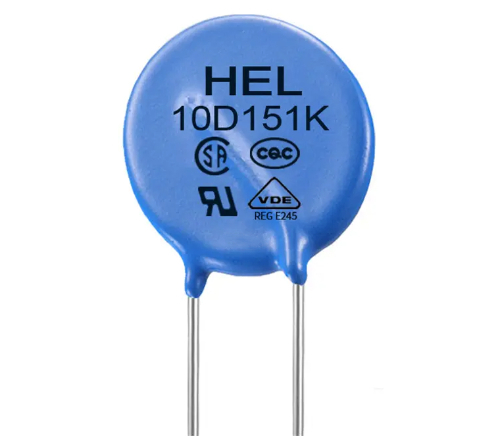
Fig. 8 Zinc Oxide Varistors
5 Lithium Niobate (LiNbO₃)
Lithium Niobate (LiNbO₃) is an important piezoelectric crystal material, which is widely used in many high-tech fields because of its excellent piezoelectric, electro-optical, non-linear optical and acoustic-optical properties. Lithium niobate has a tetragonal crystal system of chalcogenide structure, the non-central symmetry of this structure gives it piezoelectric and electro-optical properties, and the relative displacement of lithium ions and niobium ions in the lattice under stress produces the shift of positive and negative charge centers.
Lithium niobate has high piezoelectric constants and electromechanical coupling coefficients, making it excellent for many applications. As a piezoelectric crystal, lithium niobate (LiNbO₃) has a wide range of applications in several fields due to its excellent piezoelectric, electro-optical, acousto-optical, and non-linear optical properties.
Lithium niobate fabricates electro-optical modulators and waveguide devices in optical devices, which are widely used in optical communications and integrated optics. In acousto-optic devices, lithium niobate is used in acousto-optic modulators and acousto-optic delay lines, which are used to modulate and process light beams and radio frequency signals.
In the field of sensors, lithium niobate accelerometers, and pressure sensors are widely used in aerospace, automotive safety systems, seismic monitoring, and industrial automation. Piezoelectric filters and resonators made of lithium niobate are used in wireless communication systems to select and control frequencies, ensuring signal clarity and transmission quality.
In laser devices, the nonlinear optical properties of lithium niobate are used in the manufacture of frequency multipliers and optical parametric oscillators to enable modulation of the laser frequency and adjustment of the wavelength. In addition, lithium niobate has important applications in the medical and biotechnology fields, such as in medical ultrasound devices and biosensors that provide high-precision ultrasound imaging and biomolecular detection.
Its high piezoelectric constant, excellent electro-optical effect, and chemical stability make lithium niobate valuable for modern electronics, communications, optics, medical and industrial automation applications.

Fig. 9 Crystal Structure of Lithium Niobate
6 Lithium Tantalate (LiTaO₃)
Lithium Tantalate (LiTaO₃) is an important piezoelectric crystal material, which is widely used in many high-tech fields because of its excellent piezoelectric, electro-optical, acousto-optical, and non-linear optical properties. Lithium tantalate has a calcite structure with a tripartite crystal system, and this non-centrosymmetric structure gives it piezoelectric, electro-optical, and nonlinear optical properties. Lithium tantalate has a high piezoelectric constant and electromechanical coupling coefficient, which can effectively convert mechanical energy into electrical energy or vice versa.
As a piezoelectric crystal, lithium tantalate (LiTaO₃) has a wide range of applications in several fields due to its excellent piezoelectric, electro-optical, acousto-optical, and non-linear optical properties.
In optical devices, LiTaO₃ is used to manufacture electro-optical modulators and optical waveguide devices, which are widely used in optical communications and integrated optics. In acousto-optic devices, lithium tantalate is used in acousto-optic modulators and acousto-optic delay lines, which are used to modulate and process light beams and radio frequency signals.
For sensor applications, lithium tantalate-based accelerometers and pressure sensors are prevalent in aerospace, automotive safety systems, seismic monitoring, and industrial automation. Its piezoelectric filters and resonators are essential in wireless communication systems to select and control frequencies, thereby ensuring signal clarity and transmission quality.
The nonlinear optical properties of lithium tantalate are crucial in laser devices, particularly in the manufacturing of frequency multipliers and optical parametric oscillators. These devices enable modulation of the laser frequency and adjustment of the wavelength. Additionally, lithium tantalate finds significant use in the medical and biotechnology sectors, such as in medical ultrasound devices and biosensors that offer high-precision ultrasound imaging and biomolecular detection.
Its robust piezoelectric constant, superior electro-optical effect, and excellent chemical stability make lithium tantalate indispensable for modern electronics, communications, optics, medical, and industrial automation applications.
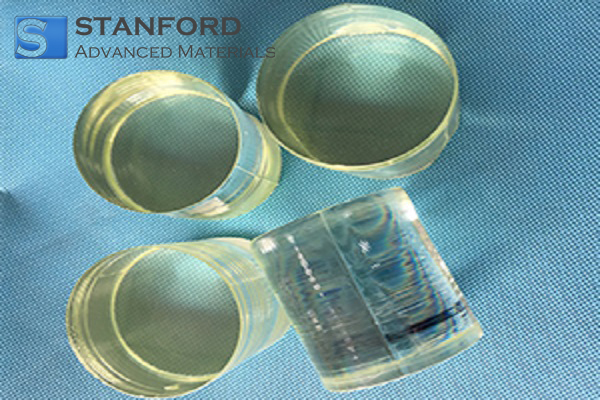
Fig. 10 Lithium Tantalate Crystal
7 Conclusion
Piezoelectric crystals have the function of interconverting mechanical and electrical energy due to their special microstructure. The discovery and application of piezoelectric crystals such as quartz, lithium niobate, and lithium tantalate have not only profoundly influenced the direction of modern scientific and technological progress, but also demonstrated the great potential of materials science in solving real-world problems.
With the increasing demand for new material properties, further innovations in piezoelectric crystal technology will continue to push the boundaries of human technology and bring more innovation and progress to our society. Stanford Advanced Materials (SAM) is at the forefront of providing high-quality piezoelectric materials to meet these growing technological needs.
References:
[1] Nogueira A E F ,Campos B V R ,Nascimento D C P J , et al.Piezoelectric temperature acoustic sensor of LiNbO3 crystal fibers operating at radio frequencies[J].Journal of Crystal Growth,2024,643127799-127799.
Related reading:


